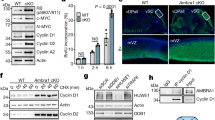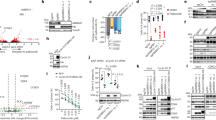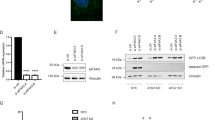Abstract
The retinoblastoma pathway is often inactivated in human tumors resulting in deregulated E2F activity that can induce both proliferation and cell death. Although the role of E2F in apoptosis is well characterized, little is known regarding its putative participation in other cell death pathways. We show here that activation of E2F1 upregulates the expression of four autophagy genes—microtubule-associated protein-1 light chain-3 (LC3), autophagy-related gene-1 (ATG1), ATG5 and damage-regulated autophagy modulator (DRAM). E2F1-mediated induction of LC3, ATG1 and DRAM is direct and indeed, endogenous E2F1 can be found bound to regions encompassing the promoters of these genes. Regulation of ATG5 by E2F1 is indirect. Importantly, we demonstrate that E2F1 activation enhances autophagy and conversely, reducing endogenous E2F1 expression inhibits DNA damage-induced autophagy. These studies identify E2F1 as a transcriptional regulator of autophagy, and for the first time establish a role for E2F1 in DNA damage-induced autophagy.
This is a preview of subscription content, access via your institution
Access options
Subscribe to this journal
Receive 50 print issues and online access
$259.00 per year
only $5.18 per issue
Buy this article
- Purchase on Springer Link
- Instant access to full article PDF
Prices may be subject to local taxes which are calculated during checkout



Similar content being viewed by others
References
Baehrecke EH . (2005). Autophagy: dual roles in life and death? Nat Rev Mol Cell Biol 6: 505–510.
Crighton D, O'Prey J, Bell HS, Ryan KM . (2007). p73 regulates DRAM-independent autophagy that does not contribute to programmed cell death. Cell Death Differ 14: 1071–1079.
Crighton D, Wilkinson S, O'Prey J, Syed N, Smith P, Harrison PR et al. (2006). DRAM, a p53-induced modulator of autophagy, is critical for apoptosis. Cell 126: 121–134.
DeGregori J, Johnson DG . (2006). Distinct and overlapping roles for E2F family members in transcription, proliferation and apoptosis. Curr Mol Med 6: 739–748.
Dimova DK, Dyson NJ . (2005). The E2F transcriptional network: old acquaintances with new faces. Oncogene 24: 2810–2826.
Edinger AL, Thompson CB . (2004). Death by design: apoptosis, necrosis and autophagy. Curr Opin Cell Biol 16: 663–669.
Feng Z, Zhang H, Levine AJ, Jin S . (2005). The coordinate regulation of the p53 and mTOR pathways in cells. Proc Natl Acad Sci USA 102: 8204–8209.
Fortin A, MacLaurin JG, Arbour N, Cregan SP, Kushwaha N, Callaghan S M et al. (2004). The proapoptotic gene SIVA is a direct transcriptional target for the tumor suppressors p53 and E2F1. J Biol Chem 279: 28706–28714.
Ginsberg D . (2002). E2F1 pathways to apoptosis. FEBS Lett 529: 122–125.
Gozuacik D, Kimchi A . (2007). Autophagy and cell death. Curr Top Dev Biol 78: 217–245.
Hershko T, Ginsberg D . (2004). Up-regulation of Bcl-2 homology 3 (BH3)-only proteins by E2F1 mediates apoptosis. J Biol Chem 279: 8627–8634.
Kabeya Y, Mizushima N, Ueno T, Yamamoto A, Kirisako T, Noda T et al. (2000). LC3, a mammalian homologue of yeast Apg8p, is localized in autophagosome membranes after processing. EMBO J 19: 5720–5728.
Kirisako T, Baba M, Ishihara N, Miyazawa K, Ohsumi M, Yoshimori T et al. (1999). Formation process of autophagosome is traced with Apg8/Aut7p in yeast. J Cell Biol 147: 435–446.
Klionsky DJ, Emr SD . (2000). Autophagy as a regulated pathway of cellular degradation. Science 290: 1717–1721.
Reef S, Zalckvar E, Shifman O, Bialik S, Sabanay H, Oren M et al. (2006). A short mitochondrial form of p19ARF induces autophagy and caspase-independent cell death. Mol Cell 22: 463–475.
Sherr CJ . (1996). Cancer cell cycles. Science 274: 1672–1677.
Shimizu S, Kanaseki T, Mizushima N, Mizuta T, Arakawa-Kobayashi S, Thompson CB et al. (2004). Role of Bcl-2 family proteins in a non-apoptotic programmed cell death dependent on autophagy genes. Nat Cell Biol 6: 1221–1228.
Stevens C, La Thangue NB . (2004). The emerging role of E2F-1 in the DNA damage response and checkpoint control. DNA Repair (Amst) 3: 1071–1079.
Tracy K, Dibling BC, Spike BT, Knabb JR, Schumacker P, Macleod KF . (2007). BNIP3 is an RB/E2F target gene required for hypoxia-induced autophagy. Mol Cell Biol 27: 06229–06242.
Tsuneoka M, Umata T, Kimura H, Koda Y, Nakajima M, Kosai K et al. (2003). c-myc induces autophagy in rat 3Y1 fibroblast cells. Cell Struct Funct 28: 195–204.
Vigo E, Muller H, Prosperini E, Hateboer G, Cartwright P, Moroni MC et al. (1999). CDC25A phosphatase is a target of E2F and is required for efficient E2F-induced S phase. Mol Cell Biol 19: 6379–6395.
Weinmann AS, Bartley SM, Zhang T, Zhang MQ, Farnham PJ . (2001). Use of chromatin immunoprecipitation to clone novel E2F target promoters. Mol Cell Biol 21: 6820–6832.
Wu X, Levine AJ . (1994). p53 and E2F-1 cooperate to mediate apoptosis. Proc Natl Acad Sci USA 91: 3602–3606.
Acknowledgements
We are grateful to Dalia Hacohen for excellent technical assistance and Yehuda Brody for statistical analysis. We thank Zvulun Elazar for helpful discussions and reagents and Uri Nir for critical reading of the manuscript. This work was supported by grants from the Israel Science Foundation (ISF), The Israel Cancer Association and The Israeli Ministry of Health to DG.
Author information
Authors and Affiliations
Corresponding author
Additional information
Supplementary Information accompanies the paper on the Oncogene website (http://www.nature.com/onc).
Supplementary information
Rights and permissions
About this article
Cite this article
Polager, S., Ofir, M. & Ginsberg, D. E2F1 regulates autophagy and the transcription of autophagy genes. Oncogene 27, 4860–4864 (2008). https://doi.org/10.1038/onc.2008.117
Received:
Revised:
Accepted:
Published:
Issue Date:
DOI: https://doi.org/10.1038/onc.2008.117
Keywords
This article is cited by
-
Metformin alleviates bone loss in ovariectomized mice through inhibition of autophagy of osteoclast precursors mediated by E2F1
Cell Communication and Signaling (2022)
-
Transcriptional targets of senataxin and E2 promoter binding factors are associated with neuro-degenerative pathways during increased autophagic flux
Scientific Reports (2022)
-
Chromatin accessibility and transcription dynamics during in vitro astrocyte differentiation of Huntington’s Disease Monkey pluripotent stem cells
Epigenetics & Chromatin (2019)
-
Long-term PGC1β overexpression leads to apoptosis, autophagy and muscle wasting
Scientific Reports (2017)
-
The lncRNA HOTAIRM1 regulates the degradation of PML-RARA oncoprotein and myeloid cell differentiation by enhancing the autophagy pathway
Cell Death & Differentiation (2017)



